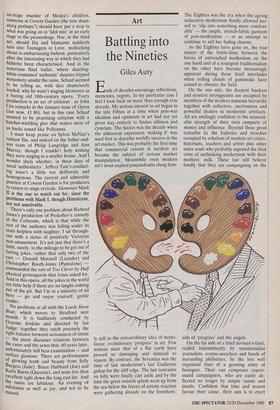Art
Battling into the Nineties
Giles Auty
Ends of decades encourage reflections, memories, regrets. In my particular case I feel I look back on more than enough eras already. My serious interest in art began in the late Fifties at a time when post-war idealism and optimism in art had not yet given way entirely to Sixties silliness and cynicism. The Sixties was the decade when the abhorrent expression 'making it' was used first to describe worldly success in the art market. This was probably the first time that commercial careers in modern art became the subject of serious market manipulation. Meanwhile even modern art's most exalted panjandrums clung firm-
ly still to the extraordinary idea of mono- linear, evolutionary 'progress' in art. Few notions since that of a flat earth have proved so damaging and inimical to reason. By contrast, the Seventies was the time of late modernism's last Gadarene gallop for the cliff edge. The last restraints on folly were finally cast aside and by the time the great swinish splash went up from the sea below the forces of artistic reaction were gathering already on the foreshore. The Eighties was the era when the ageing seductress modernism finally allowed her- self to 'slip into something more comfort- able' — the ample, stretch-fabric garment of post-modernism — in an attempt to continue to sell her fading charms.
As the Eighties have gone on, the true nature of the battle-lines between the forces of entrenched modernism on the one hand and of a resurgent traditionalism on the other have become increasingly apparent during those brief interludes when rolling clouds of gunsmoke have ceased to obscure the field.
On the one side, the deepest bunkers and stoutest strongpoints are occupied by members of the modern museum hierarchy together with collectors, auctioneers and powerful dealers in modernist artefacts. All are smilingly confident in the unassail- able strength of their twin ramparts of money and influence. Beyond these great redoubts lie the foxholes and trenches occupied by echelons of modern art critics, historians, teachers and artists plus other naïve souls who probably ingested the fatal virus of unthinking modernism with their mothers' milk. These last still believe fondly that they are campaigning on the side of 'progress' and the angels.
On the far side of a brief no-man's-land, raided intermittently by sensationalist journalists, corpse-snatchers and bands of marauding philistines, lie the less well organised lines of a growing army of besiegers. Their van comprises experi- enced campaigners, who are easily de- flected no longer by simple taunts and insults. Confident that time and reason favour their cause, their aim is to exert unremitting pressure on the weaker links of the opponents' defences. While the besiegers' central core is intellectual, their larger support is drawn from the classes of the intelligent but uninitiated. Meanwhile their army of foot-soldiers and camp- followers is legion but is sadly inclined to fraternise too often with the philistines. Such action allows the opposition the valuable claim, of course, that it is philis- tinism itself they are fighting. While one side campaigns under the dual banners of modernism and mammon, the other cru- sades for what it believes could be a true and overdue artistic renascence. Those who practise as painters and sculptors fight on both sides in the war and are among the bitterest of opponents. While the mer- chants of modernism lack sustainable objectives beyond those of self-interest, their besiegers suffer from lack of common causes and cohesion. Perhaps the latter side's most recent and valuable boast is a royal champion who had raised his stan- dard squarely in their lines. Yet being the royal heir, of itself, does not protect him from the skills of opposition sharpshooters.
As the Nineties lurch over the horizon and into view, what is my forecast of the outcome of the struggle? Recent events in Eastern Europe have shown that entren- ched power is not always or necessarily victorious in the long run. I cited the Turner Prize recently as a prime example of art-world realpolitik. It has attracted bad press comment consistently since its incep- tion, yet those concerned continue to behave blithely as though its contrived results mean something. Clearly we con- tinue to live under an imposed culture which may prove vulnerable in the long term only because it is lacking almost entirely in popular support. The next ten years, in my view, will see more and more artists of all ages renegotiating their pacts with the great pre-modern heritage of European art. I have argued many times already that we must henceforward alter our use of the word 'modern', as in Museum of Modern Art, quite radically to take in all work done in the contemporary period without any of the present strong bias towards purely formal innovation. In short, art is an area of thought where better ideas should and would prevail sooner rather than later were it not for vested interests determined to see inflated modern art prices and reputations survive.











































































































 Previous page
Previous page